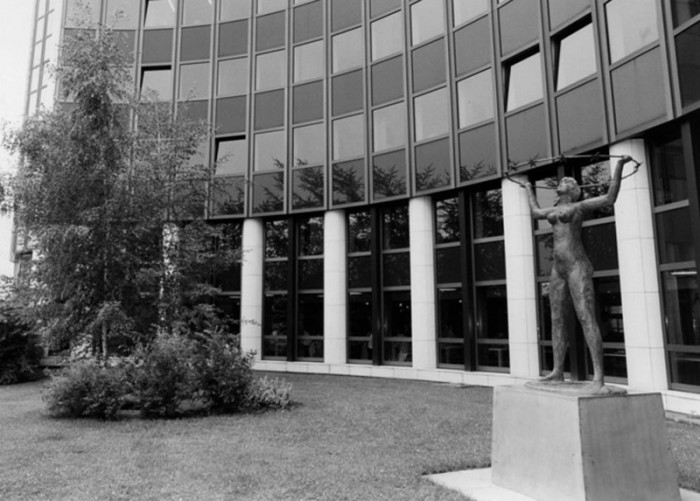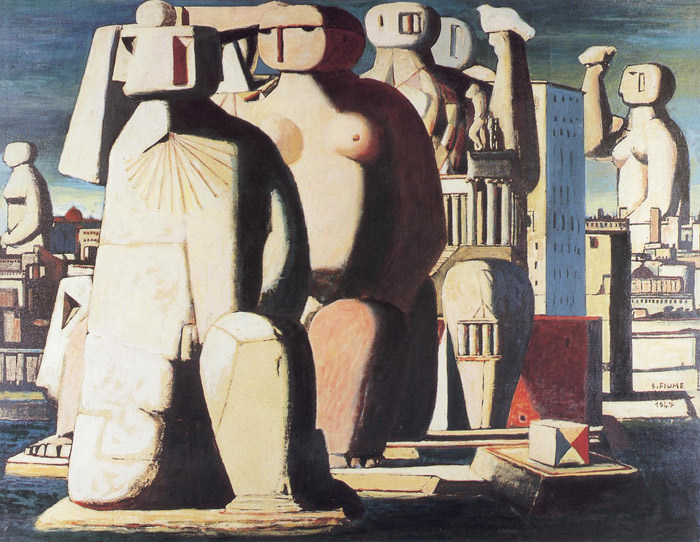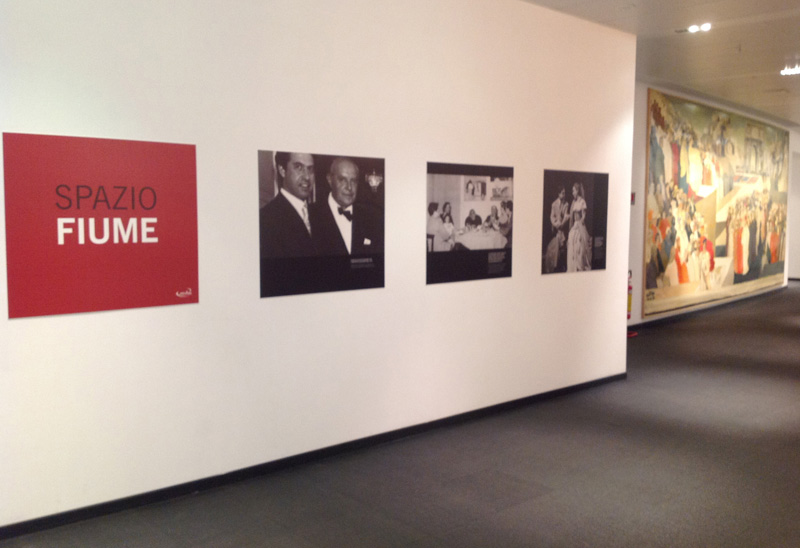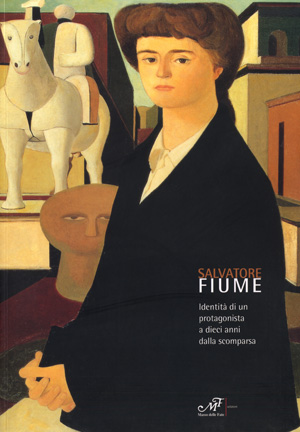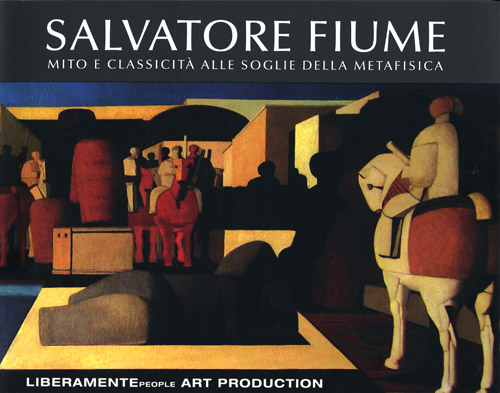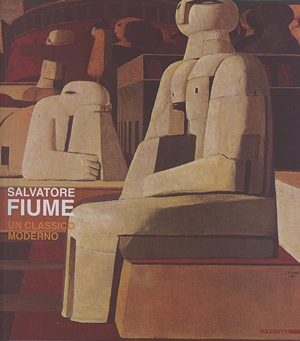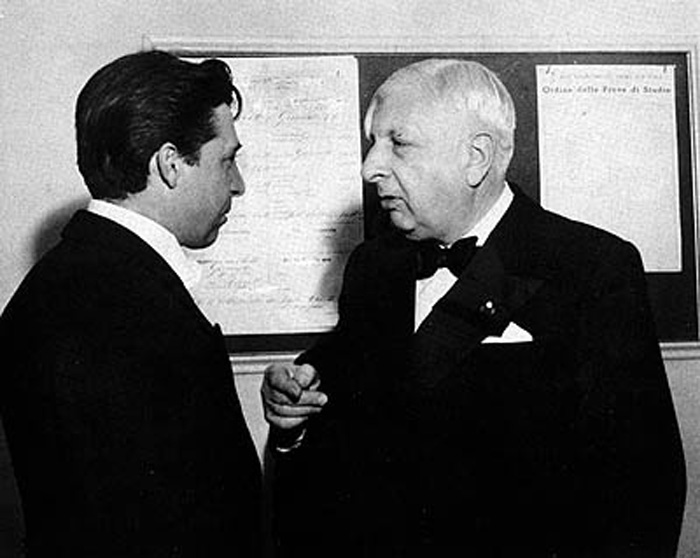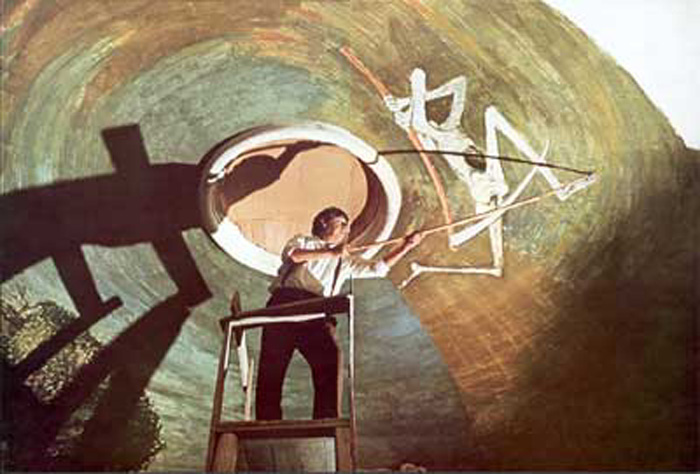BIOGRAPHY
GALLERIES
Born in Comiso, Sicily, on the 23rd of October, 1915 Salvatore Fiume was a painter, sculptor, architect, writer, and stage designer. At age sixteen he won a scholarship for the Royal Institute for the Book Illustration in Urbino, where he acquired a deep knowledge of printing techniques such as lithography, serigraphy, etching, and xylography. After finishing his studies, in 1936 he moved to Milan where he became friends with important writers such as Dino Buzzati and Salvatore Quasimodo, (the latter was to gain the Nobel Prize in 1959).
In 1938 he moved to Ivrea as art director of the Olivetti cultural magazine that was particularly dear to president Adriano Olivetti and whose prestigious collaborators were intellectuals like Franco Fortini and Leonardo Sinisgalli. Although he wanted to make a career as a painter Fiume’s first success came in 1943 with the publication of his autobiographical novel Viva Gioconda! (Hurrah for Gioconda!) by Bianchi-Giovini publishers of Milan.
In order to completely devote himself to painting, in 1946 Fiume left Olivetti and moved to Canzo, near Como, where he adapted a huge 19th Century spinning mill into a studio which was later to become also his permanent home (now it is the home of the Salvatore Fiume Foundation). In 1948, as his painting, then deeply influenced by the Italian Quattrocento and by the metaphysical painting of de Chirico, Savinio, and Carrà, had difficulty in establishing itself, Fiume carried out a series of works inspired from the Spanish tradition and folklore and signed them F. Queyo, an inexistent Gitano painter whose story as political exile living in Paris was totally invented by Fiume.
The paintings were exhibited successfully at the Galleria Gussoni of Milan.1949 was the year of his first official exhibition which took place at the Galleria Borromini of Milan. There Fiume’s Cities of Statues and Islands of Statues attracted the attention of the critics and these paintings soon became known throughout the art community. During that exhibition Alfred H. Barr Jr., Director of Collections of the MoMA of New York, acquired the 1947 Città di statue now in the collections of that museum. The Jucker Collection of Milan also acquired a painting from that exhibition. In 1950 Alberto Savinio, Giorgio de Chirico’s brother, promoted Fiume’s participation in the Biennale of Venice where he exhibited the triptych Isola di statue, now in the Vatican Museum. This gained him a full page in “Life Magazine”.
Fiume’s first experience as stage designer, again on Alberto Savinio’s advice, was in 1952 when he designed the sets and costumes of De Falla’s The Short Life for The Scala Theatre, followed by Beethoven’s ballet The Creatures of Prometheus, also in 1952. Next came Cherubini’s Medea (1953), Respighi’s The Flame (1954), Bellini’s Norma (1955), Verdi’s Nabucco (1958), Rossini’s William Tell (1965). He also collaborated with other important opera houses such as the Covent Garden of London (Verdi’s Aida, 1957) the Teatro Massimo of Palermo (Bellini’s The Capulets and The Montagues, 1954), and the Montecarlo Opera House (Donizzetti’s The Bell, 1992), which concluded his collaboration with the opera theatre.
In 1951 the distinguished Italian architect Gio Ponti asked Fiume to paint a huge canvas (450 x 9 ft) to be affixed in the main lounge of the Andrea Doria liner. In that painting Fiume represented an imaginary Italian Renaissance city where visitors could have a pre-view of some of the masterpieces they would admire in Italy. Unfortunately in 1956 the huge canvas sank with the ship off the shore of the Island of Nantucket, Massachusetts.
In 1953 Fiume was commissioned by the New York based “Life” and “Times” Magazines three island of statues re-inventions of the history of Manhattan and the Bay of New York for their headquarters.
Between 1949 and 1952, invited by entrepreneur Bruno Buitoni Sr. to illustrate “the adventures, misfortunes, and glories” of the old Umbria Region. Fiume completed ten large paintings inspired from Italian Quattrocento masters like Piero della Francesca and Paolo Uccello. This cycle is now in the Sala Fiume at Palazzo Donini in Perugia, the head office of the Umbria Region.
In 1962 a travelling exhibition of about 100 Fiume paintings was hosted in Germany by a number of museums in various towns including Cologne and Regensburg. In 1967 he painted the sketch for the large mosaic in the Annunciation Basilica of Nazareth in the Holy Land. In 1973, accompanied by his friend the photographer Walter Mori, Fiume travelled to the Babile Valley in Ethiopia where he painted his islands on a group of rocks using marine paint.
In 1974 the Palazzo Reale of Milan hosted a large anthological by Fiume. There he exhibited a partial chalk and polyurethane reproduction of the rocks he had painted in Ethiopia, which occupied the huge Sala delle Cariatidi almost entirely. On the same occasion Fiume presented his African Mona Lisa, a tribute to the beauty of African women, inspired from Leonardo’s Mona Lisa, now at the Vatican Museum. In 1975 the little town of Fiumefreddo Bruzio in Southern Italy welcomed enthusiastically Fiume’s proposal of revitalizing its old historical centre free of charge. So, in 1975-1976 he frescoed some of the internal and external walls of the old tumbledown castle, and in 1976 he painted the vault of the Chapel of San Rocco.
His first sculpture exhibition was in 1976 at the Galleria l’Isola of Milan. Fiume’s production as a sculptor also includes a number of large sculptures such as the bronze statue at the European Parliament House in Strasburg, the stone group at the S.Raffaele Hospital of Rome, the bronze in the S.Raffaele Hospital of Milan, the bronze group for the Wine Fountain at Marsala, Sicily, the two bronzes in the two main squares of Fiumefreddo, and two bronzes at the Sculpture Museum of Portofino. In 1995 the Centro Allende open space of La Spezia hosted his last sculpture exhibition. In 1985 he held a large exhibition of paintings at Castel Sant’Angelo in Rome. In 1987 a Fiume exhibition entitled De Architectura Pingendi was inaugurated by Prince Ranieri of Monaco at the Sporting D’Hiver in Montecarlo. In 1991 he presented his architectural projects at the International Show of Architecture at the Triennale of Milan and in 1992 he held an exhibition at Villa Medici, seat of the French Academy in Rome.
In 1993 Fiume travelled to the Polynesian places linked with the life of Gauguin and, as a tribute to that great French master he donated one of his paintings to the Gauguin Museum of Papeari in Tahiti. In the same year he also held an exhibition at the International Exhibition Centre in Moscow. Beside Viva Gioconda!, quite a successful novel, Fiume published many short stories, nine comedies, one tragedy, and two collections of poems. In 1988 he received an honorary degree in Modern Literature from the University of Palermo.
His works can be found in some of the most important museums such as the Hermitage Museum of St. Petersburg, the MoMA of New York, the Puškin Museum of Moscow, and the Museum of Modern Art of Milan. Since 1978 a collection of 33 paintings by Fiume is hosted in the Vatican Museums, a collection that synthesizes the main themes of his production.
He died in Milan on June 3, 1997. Among the exhibitions on Fiume’s work held since 1997, some stand out from the others, like the one at the Santerasmo Gallery of Milan in 1997 entitled The Pictorial Alliances, the anthological exhibition at the Gualtieri Castle near Reggio Emilia in 1998, and the portrait exhibition entitled The Body and the Soul at the Santerasmo Gallery of Milan in 1999. A large exhibition entitled Salvatore Fiume: Myths Hypotheses Metaphors was held in 2001 in Canzo, near Como, where Fiume had lived since 1946. The two exhibitions held in 2006 in Vilnius, Lithuania and Warsaw, Poland in their respective Italian Cultural Institutes, are also worth mentioning together with the large retrospective (207 works) held in Arezzo in 2007 for the tenth anniversary of Fiume’s death. In 2008 the Auditorium-Parco della Musica of Rome hosted a Fiume exhibition entitled Myth and the Classical Spirit on the Threshold of Metaphysics.
Between December 2010 and February 2011 a Fiume retrospective entitled Salvatore Fiume: A Nonconformist of the 20th Century was held at the Spazio Oberdan of Milan (100 works including paintings, drawings and sculptures).
Dell’ottobre 2012 è la mostra Le Identità di Salvatore Fiume, 50 Opere Anni ’40-’90 a Palazzo Pirelli, Milano. Il comune di Varese ha acquistato una sua scultura che è stata posizionata nel 2012 nella Piazza del Tribunale. Fra il 2012 e il 2013 i figli di Salvatore Fiume hanno donato undici opere di grandi dimensioni alla Regione Lombardia che le ospita nello Spazio Fiume all’interno del nuovo Palazzo Lombardia a Milano. Inoltre, una sua scultura è stata posizionata a Milano in Piazza Piemonte il 23 ottobre 2013, nel giorno in cui Fiume avrebbe compiuto 98 anni.

